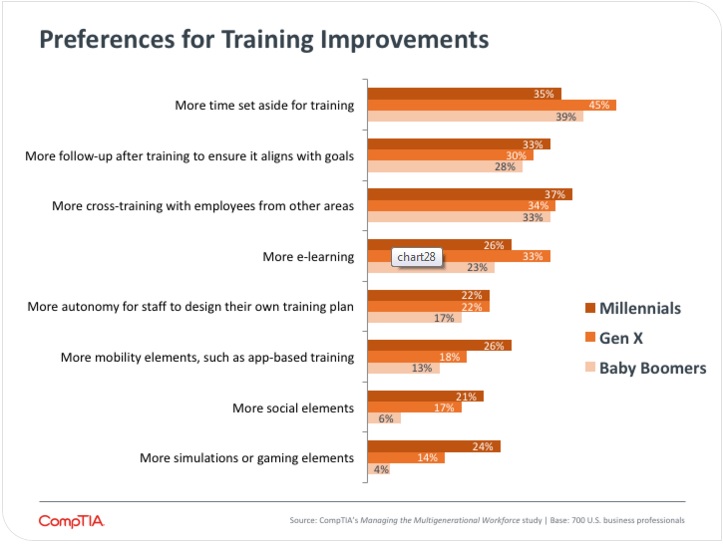The Internet has changed how we work in innumerable ways, including the manner in which training and professional development takes place. Whether enabling workers to pursue informal self-study online, review work manuals and other training guides virtually, or participate in full-on e-learning courses with or without an instructor, the Internet has broadened the number of options today’s workforce has to develop new skills and grow in their careers.
E-learning is a perfect example. Thirty-four percent of all respondents report that e-learning was a training methodology they used in the past 12 months. When CompTIA surveyed workers two years ago, Millennial workers availed themselves of e-learning at a much higher rate than older workers. In this iteration of the study, the percentage of workers using e-learning was found to be fairly consistent across all generations. This indicates that e-learning is now more of the norm and is appealing to all workers who want to be autonomous in how they choose to interact with technology, decide their own pace, and take training without being forced to interrupt normal workflow.
Yet despite the attraction to e-learning, many of today’s more common training mechanisms remain conventional in nature, including self-study with review guides (40 percent), informal education by peers and managers (39 percent), and instructor-led classroom sessions (33 percent). As training becomes more digital, new elements will need to be added to increase engagement and effectiveness.
The bottom line is that workers of all ages desire training for skills, but the format for that training is changing as new workers build skills and advance their careers. As companies rely more on certification for proving skills and training for keeping those skills in-house, they will have to transform the types of training they offer to fit the current mindset.

Looking ahead, younger generations are increasingly interested in expanding how they receive training to include more progressive means such as social media elements, mobility elements and simulations or gaming type constructs. In the previous iteration of this survey, nearly half of workers in their 20s and 30s said the use of mobility and social media as platforms for professional development and training would be beneficial. In the current iteration, just about a third find these elements desirable. This could be because many of these elements are now being built into training and professional development. About a quarter of millennial workers want more simulation or gaming elements. By contrast, just 4 percent of baby boomers cited this as a potentially useful methodology.
The bottom line is that workers of all ages desire training for skills, but the format for that training is changing as new workers build skills and advance their careers. As companies rely more on certification for proving skills and training for keeping those skills in-house, they will have to transform the types of training they offer to fit the current mindset.

